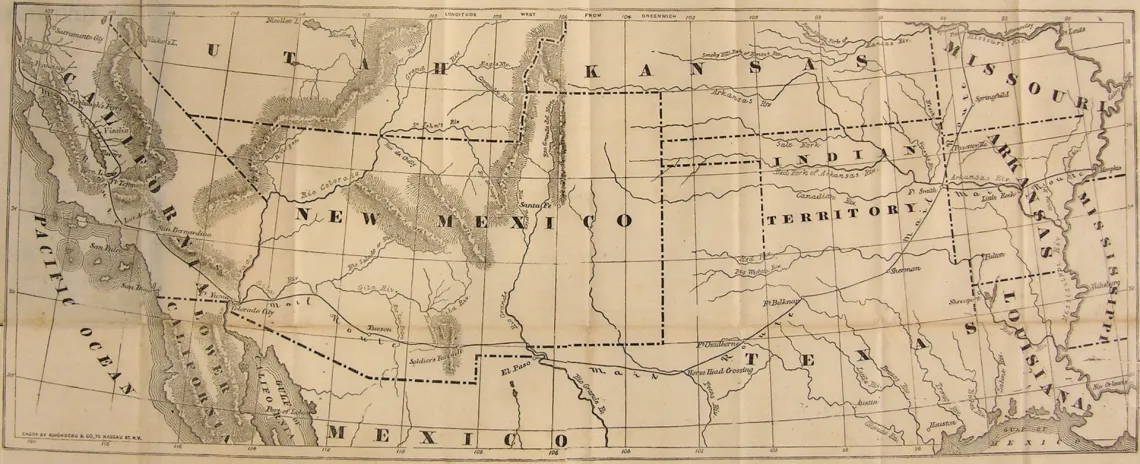
The stage routes from a Butterfield Overland Mail Company map. Public domain.
Throughout the Spanish and Mexican era, the principal modes of transportation were foot and horseback. Wagons moved freight and people across the landscape. At first there were few established transportation routes through the region. Native scouts familiar with traditional trade routes likely led the earliest explorers. These were little more than footpaths following rivers and foothills. Regular routes were established by the early territorial days. The U.S. military mapped many of these trails and established wagon roads that linked their outposts and communities in the region. In the late 1840s, the military established a wagon road that linked Santa Fe and California via southern Arizona. Large numbers of emigrants passed along this and other wagon roads during the California Gold Rush in 1849. Travelers were under constant treat from brigands and Apache raiders until the suppression of the Apache and the arrival of the railroad made travel much less dangerous and inconvenient.
The first organized semipublic transportation in southern Arizona appears to have been the San Antonio and San Diego Mail Line, established in 1857. The following year the route was acquired by the Butterfield Overland Mail Company, which established a system of twenty-six stage stations along the trail across southern Arizona. As the population of the territory increased, so did the need for secondary routes that linked developing communities. In some cases, these links spurred the development of local stage and mail routes. One such route linked Tombstone with Tucson. These mail and stage companies were eventually eclipsed by the development of the telegraph and the subsequent arrival of the railroad.
The construction of the Southern Pacific Railroad across southern Arizona in the late 1870s was a watershed event for the region. The line essentially followed the stage trail across the region, linking Tucson and its surrounding region with the shipping ports of the west coast and ultimately the eastern states. For the first time, it was feasible to ship perishable goods: for example, archaeologists find marine oyster shell in the middens of Tucson households dating to the 1880s. The railroad also had a tremendous impact on the mining industry throughout southern Arizona. The transportation of large quantities of ore from mines to smelters became more economical. Indeed, after the establishment of a main line across the region, there was an explosion in construction of smaller lines that serviced specific mines and mining districts.
One such line was the Arizona Southern Railroad, constructed in 1904 to link mines in the Silver Bell District with a smelter at the town of Sasco, and then to the main line down the Santa Cruz valley between Maricopa and Tucson. Despite brief periods of interruption, this line continued in service until 1933. Other spurs linked Nogales (Southern Pacific 1920) and the Tombstone-Bisbee Districts (Arizona and Southeastern 1888–1889 / El Paso and Southwestern 1901). By the time Arizona achieved statehood in 1912, nearly 1700 miles of railroad track had been built throughout the state.
The demand for cotton, copper, and beef during the period immediately before and during World War I provided a boon to the local economy. Nearly 40 percent of the copper mined in the U.S. came from Arizona mines. With the demand for wiring, copper shell casings, and other necessities, the price for copper nearly doubled between 1914 and 1916. Cotton provided another source of financial wealth during these years. By 1919 there were 82,000 acres under cotton cultivation, with cotton selling for $406 a bale—up from $233 a bale. The boom went bust the next year. In 1920 the total acreage in Arizona and California leaped to a total of around 243,000, with the expectation of expansion and higher profits. But the military suddenly canceled many of its contracts, and Egyptian cotton, which had been under embargo during the war years, flooded the market. The price of Arizona “King Cotton” plummeted from an anticipated $1.50/pound to around $0.28/pound, which bankrupted many farmers and contributed to a financial crisis in the general economy. Banks became insolvent and many struggling corporations were bought by larger commercial entities. The impact on migrant laborers was equally devastating, with growers who could not meet their payrolls suddenly dumping thousands of workers. This stretched the resources of the fledgling state and led to a crackdown on immigration—both legal and illegal—and the forced repatriation of many individuals who were already residents. It took a number of years for the economy of Arizona, and the nation, to recover from the post-War depression.





